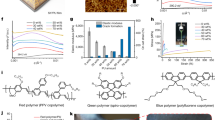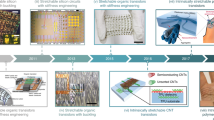Abstract
Skin-like intrinsically stretchable soft electronic devices are essential to realize next-generation remote and preventative medicine for advanced personal healthcare1,2,3,4. The recent development of intrinsically stretchable conductors and semiconductors has enabled highly mechanically robust and skin-conformable electronic circuits or optoelectronic devices2,5,6,7,8,9,10. However, their operating frequencies have been limited to less than 100 hertz, which is much lower than that required for many applications. Here we report intrinsically stretchable diodes—based on stretchable organic and nanomaterials—capable of operating at a frequency as high as 13.56 megahertz. This operating frequency is high enough for the wireless operation of soft sensors and electrochromic display pixels using radiofrequency identification in which the base-carrier frequency is 6.78 megahertz or 13.56 megahertz. This was achieved through a combination of rational material design and device engineering. Specifically, we developed a stretchable anode, cathode, semiconductor and current collector that can satisfy the strict requirements for high-frequency operation. Finally, we show the operational feasibility of our diode by integrating it with a stretchable sensor, electrochromic display pixel and antenna to realize a stretchable wireless tag. This work is an important step towards enabling enhanced functionalities and capabilities for skin-like wearable electronics.
This is a preview of subscription content, access via your institution
Access options
Access Nature and 54 other Nature Portfolio journals
Get Nature+, our best-value online-access subscription
$29.99 / 30 days
cancel any time
Subscribe to this journal
Receive 51 print issues and online access
$199.00 per year
only $3.90 per issue
Buy this article
- Purchase on Springer Link
- Instant access to full article PDF
Prices may be subject to local taxes which are calculated during checkout




Similar content being viewed by others
Data availability
Source data are provided with this paper.
References
Sim, K. et al. An epicardial bioelectronic patch made from soft rubbery materials and capable of spatiotemporal mapping of electrophysiological activity. Nat. Electron. 3, 775–784 (2020).
Wang, S. et al. Skin electronics from scalable fabrication of an intrinsically stretchable transistor array. Nature 555, 83–88 (2018).
Miyamoto, A. et al. Inflammation-free, gas-permeable, lightweight, stretchable on-skin electronics with nanomeshes. Nat. Nanotechnol. 12, 907–913 (2017).
Kim, D.-H. et al. Epidermal electronics. Science 333, 838–843 (2011).
Zheng, Y. et al. Monolithic optical microlithography of high-density elastic circuits. Science 373, 88–94 (2021).
Liang, J., Li, L., Niu, X., Yu, Z. & Pei, Q. Elastomeric polymer light-emitting devices and displays. Nat. Photon. 7, 817–824 (2013).
Kim, H., Sim, K., Thukral, A. & Yu, C. Rubbery electronics and sensors from intrinsically stretchable elastomeric composites of semiconductors and conductors. Sci. Adv. 3, e1701114 (2017).
Kim, J.-H. & Park, J.-W. Intrinsically stretchable organic light-emitting diodes. Sci. Adv.7, eabd9715 (2021).
Wang, Z. et al. Intrinsically stretchable organic solar cells beyond 10% power conversion efficiency enabled by transfer printing method. Adv. Funct. Mater. 31, 2103534 (2021).
Noh, J. et al. Intrinsically stretchable organic solar cells with efficiencies of over 11%. ACS Energy Lett. 6, 2512–2518 (2021).
Kaltenbrunner, M. et al. An ultra-lightweight design for imperceptible plastic electronics. Nature 499, 458–463 (2013).
Minev, I. R. et al. Electronic dura mater for long-term multimodal neural interfaces. Science 347, 159–163 (2015).
Khodagholy, D. et al. NeuroGrid: recording action potentials from the surface of the brain. Nat. Neurosci. 18, 310–315 (2015).
Wang, C., Wang, C., Huang, Z. & Xu, S. Materials and structures toward soft electronics. Adv. Mater. 30, 1801368 (2018).
Kim, D.-H. et al. Dissolvable films of silk fibroin for ultrathin conformal bio-integrated electronics. Nat. Mater. 9, 511–517 (2010).
Gao, W. et al. Fully integrated wearable sensor arrays for multiplexed in situ perspiration analysis. Nature 529, 509–514 (2016).
Matsuhisa, N., Chen, X., Bao, Z. & Someya, T. Materials and structural designs of stretchable conductors. Chem. Soc. Rev. 48, 2946–2966 (2019).
Wang, S., Oh, J. Y., Xu, J., Tran, H. & Bao, Z. Skin-inspired electronics: an emerging paradigm. Acc. Chem. Res. 51, 1033–1045 (2018).
Kim, H., Thukral, A., Sharma, S. & Yu, C. Biaxially stretchable fully elastic transistors based on rubbery semiconductor nanocomposites. Adv. Mater. Technol. 3, 1800043 (2018).
Sim, K. et al. Fully rubbery integrated electronics from high effective mobility intrinsically stretchable semiconductors. Sci. Adv. 5, 14 (2019).
Niu, S. et al. A wireless body area sensor network based on stretchable passive tags. Nat. Electron. 2, 361–368 (2019).
Huang, Z. et al. Three-dimensional integrated stretchable electronics. Nat. Electron. 1, 473–480 (2018).
Bandodkar, A. J. et al. Battery-free, skin-interfaced microfluidic/electronic systems for simultaneous electrochemical, colorimetric, and volumetric analysis of sweat. Sci. Adv. 5, 587 (2019).
Steudel, S. et al. Comparison of organic diode structures regarding high-frequency rectification behavior in radio-frequency identification tags. J. Appl. Phys. 99, 114519 (2006).
Viola, F. A. et al. A 13.56 MHz rectifier based on fully inkjet printed organic diodes. Adv. Mater. 32, 2002329 (2020).
Higgins, S. G., Agostinelli, T., Markham, S., Whiteman, R. & Sirringhaus, H. Organic diode rectifiers based on a high‐performance conjugated polymer for a near‐field energy‐harvesting circuit. Adv. Mater. 29, 1703782 (2017).
Zhou, X., Yang, D. & Ma, D. Extremely low dark current, high responsivity, all-polymer photodetectors with spectral response from 300 nm to 1000 nm. Adv. Opt. Mater. 3, 1570–1576 (2015).
Huang, J. et al. A high-performance solution-processed organic photodetector for near-infrared sensing. Adv. Mater. 32, 1906027 (2020).
Heljo, P. S., Schmidt, C., Klengel, R., Majumdar, H. S. & Lupo, D. Electrical and thermal analysis of frequency dependent filamentary switching in printed rectifying diodes. Org. Electron. 20, 69–75 (2015).
Bose, I., Tetzner, K., Borner, K. & Bock, K. Air-stable, high current density, solution-processable, amorphous organic rectifying diodes (ORDs) for low-cost fabrication of flexible passive low frequency RFID tags. Microelectron. Reliab. 54, 1643–1647 (2014).
Lee, Y. et al. Standalone real-time health monitoring patch based on a stretchable organic optoelectronic system. Sci. Adv. 7, eabg9180 (2021).
Gao, H., Chen, S., Liang, J. & Pei, Q. Elastomeric light emitting polymer enhanced by interpenetrating networks. ACS Appl. Mater. Interfaces 8, 32504–32511 (2016).
Li, L. et al. A solid-state intrinsically stretchable polymer solar cell. ACS Appl. Mater. Interfaces 9, 40523–40532 (2017).
Hsieh, Y. T. et al. Realization of intrinsically stretchable organic solar cells enabled by charge-extraction layer and photoactive material engineering. ACS Appl. Mater. Interfaces 10, 21712–21720 (2018).
Liu, N. et al. Ultratransparent and stretchable graphene electrodes. Sci. Adv. 3, e1700159 (2017).
Matsuhisa, N. et al. High‐transconductance stretchable transistors achieved by controlled gold microcrack morphology. Adv. Electron. Mater. 5, 1900347 (2019).
Zhou, Y. et al. A universal method to produce low-work function electrodes for organic electronics. Science 336, 327–332 (2012).
Wang, Y. et al. A highly stretchable, transparent, and conductive polymer. Sci. Adv. 3, e1602076 (2017).
Lipomi, D. J., Tee, B. C.-K., Vosgueritchian, M. & Bao, Z. Stretchable organic solar cells. Adv. Mater. 23, 1771–1775 (2011).
Steudel, S. et al. 50 MHz rectifier based on an organic diode. Nat. Mater. 4, 597–600 (2005).
Kang, C. et al. 1 GHz pentacene diode rectifiers enabled by controlled film deposition on SAM-treated Au anodes. Adv. Electron. Mater. 2, 1500282 (2016).
Matsuhisa, N. et al. A mechanically durable and flexible organic rectifying diode with a polyethylenimine ethoxylated cathode. Adv. Electron. Mater. 2, 1600259 (2016).
Borchert, J. W. et al. Flexible low-voltage high-frequency organic thin-film transistors. Sci. Adv. 6,1–9 (2020).
Yamamura, A. et al. Wafer-scale, layer-controlled organic single crystals for high-speed circuit operation. Sci. Adv. 4, 21 (2018).
Wang, X. et al. Printed conformable liquid metal e‐skin‐enabled spatiotemporally controlled bioelectromagnetics for wireless multisite tumor therapy. Adv. Funct. Mater. 29, 1907063 (2019).
Liu, Z. et al. Thickness-gradient films for high gauge factor stretchable strain sensors. Adv. Mater. 27, 6230–6237 (2015).
JK O’Neill, S. et al. A carbon flower based flexible pressure sensor made from large‐area coating. Adv. Mater. Interfaces 7, 2000875 (2020).
Jeon, J., Lee, H.-B.-R. & Bao, Z. Flexible wireless temperature sensors based on Ni microparticle-filled binary polymer composites. Adv. Mater. 25, 850–855 (2013).
Wang, C. et al. Thiophene-diketopyrrolopyrrole-based quinoidal small molecules as solution-processable and air-stable organic semiconductors: tuning of the length and branching position of the alkyl side chain toward a high-performance n-channel organic field-effect tran. ACS Appl. Mater. Interfaces 7, 15978–15987 (2015).
Ito, Y. et al. Crystalline ultrasmooth self-assembled monolayers of alkylsilanes for organic field-effect transistors. J. Am. Chem. Soc. 131, 9396–9404 (2009).
Tahk, D., Lee, H. H. & Khang, D.-Y. Elastic moduli of organic electronic materials by the buckling method. Macromolecules 42, 7079–7083 (2009).
Kawahara, J., Ersman, P. A., Engquist, I. & Berggren, M. Improving the color switch contrast in PEDOT:PSS-based electrochromic displays. Org. Electron. 13, 469–474 (2012).
Acknowledgements
This work was partially supported by SAIT, Samsung Electronics Co., Ltd., and the Agency for Science, Technology and Research (A*STAR) under its Advanced Manufacturing and Engineering (AME) Programmatic Scheme (no. A18A1b0045). N.M. was partially supported by a Japan Society for the Promotion of Science (JSPS) overseas research fellowship. Part of this work was performed at the Stanford Nano Shared Facilities (SNSF), supported by the National Science Foundation under award ECCS-1542152. Grazing incidence X-ray diffraction measurements were carried out at the Stanford Synchrotron Radiation Laboratory (SSRL), a national user facility operated by Stanford University on behalf of the US Department of Energy, Office of Basic Energy Sciences. Experiments performed during revision were carried out in Keio University and was supported by JST, PRESTO Grant Number JPMJPR20B7, Japan.
Author information
Authors and Affiliations
Contributions
N.M., S.N., X.C. and Z.B. designed the project and experiments. S.N. and D.Z. performed the simulation of a diode, circuit and wireless communication. T.K. designed DPP4T-oSi10. Y.O., T.K., M.A., G.-J.N.W. and Y.Z. synthesized DPP4T-oSi10. N.M., Y.O., T.K. and H.-C.W. characterized DPP4T-oSi10. J.K. synthesized ION E. N.M., S.J.K.O., H.-C.W. and R.N. developed stretchable PEDOT:PSS. H.G. performed XPS. N.M., S.J.K.O., R.N., I.Y. and Z.Z. developed stretchable AgNWs. N.M., S.J.K.O., R.N. and X.G. developed the fabrication process of stretchable diodes. N.M. and X.W. fabricated O-GaIn. N.M., S.N. and X.C. developed CNT strain sensors. N.M. and S.J.K.O. developed stretchable ECDs. S.N. developed the flexible power-supply circuit. N.M., S.N., J.B.-H.T. and Z.B. wrote the manuscript.
Corresponding author
Ethics declarations
Competing interests
The authors declare no competing interests.
Additional information
Peer review information Nature thanks the anonymous reviewers for their contribution to the peer review of this work.
Publisher’s note Springer Nature remains neutral with regard to jurisdictional claims in published maps and institutional affiliations.
Supplementary information
Supplementary Information
This file contains Supplementary Figs. 1–50, Tables 1–60 and Notes I–XIV.
Supplementary Data
This file contains the source data of the plots in the Supplementary Information.
Supplementary Video 1
Operation of the stretchable ECD under 0% strain. The ECD showed a fast response up to 10 Hz.
Supplementary Video 2
Operation of the stretchable ECD under 20% strain. The ECD showed a fast response up to 10 Hz.
Supplementary Video 3
Operation of the stretchable ECD under 50% strain. The ECD showed a fast response up to 10 Hz.
Supplementary Video 4
Wireless operation of the stretchable sensor and display system. Strain larger than 20% increased the resistance of the integrated strain sensor, and a clear colour change of the ECD was observed.
Rights and permissions
About this article
Cite this article
Matsuhisa, N., Niu, S., O’Neill, S.J.K. et al. High-frequency and intrinsically stretchable polymer diodes. Nature 600, 246–252 (2021). https://doi.org/10.1038/s41586-021-04053-6
Received:
Accepted:
Published:
Issue Date:
DOI: https://doi.org/10.1038/s41586-021-04053-6
This article is cited by
-
Stretchable and self-healing conductive fibers from hierarchical silver nanowires-assembled network
Nano Research (2024)
-
An interfacial robust and entire self-healing ionogel-elastomer hybrid for elastic electronics enables discretionary assembly and reconfiguration
Science China Chemistry (2024)
-
High-speed and large-scale intrinsically stretchable integrated circuits
Nature (2024)
-
Environmentally stable and stretchable polymer electronics enabled by surface-tethered nanostructured molecular-level protection
Nature Nanotechnology (2023)
-
Ultralow contact resistance in organic transistors via orbital hybridization
Nature Communications (2023)
Comments
By submitting a comment you agree to abide by our Terms and Community Guidelines. If you find something abusive or that does not comply with our terms or guidelines please flag it as inappropriate.



